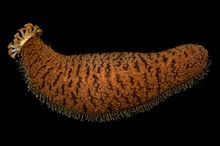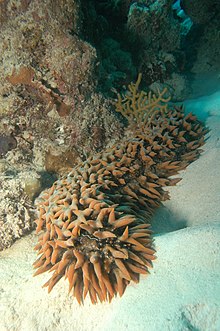
Back Seekomkommer Afrikaans خيار البحر Arabic عرناكو ARY خيار البحر ARZ Dəniz xiyarları Azerbaijani دنیز خیارلاری AZB Галатурыі Byelorussian Галятурыі BE-X-OLD Морски краставици Bulgarian সামুদ্রিক শসা Bengali/Bangla
| Sea cucumber Temporal range:
| |
|---|---|

| |
| A sea cucumber (Actinopyga echinites), displaying its feeding tentacles and tube feet | |
| Scientific classification | |
| Domain: | Eukaryota |
| Kingdom: | Animalia |
| Phylum: | Echinodermata |
| Subphylum: | Echinozoa |
| Class: | Holothuroidea Blainville, 1834 |
| Orders | |
| |

Sea cucumbers are echinoderms from the class Holothuroidea (/ˌhɒləˌθjʊəˈrɔɪdiə, ˌhoʊ-/ HOL-ə-thure-OY-dee-ə, HOHL-). They are marine animals with a leathery skin and an elongated body containing a single, branched gonad. They are found on the sea floor worldwide. The number of known holothurian (/ˌhɒləˈθjʊəriən, ˌhoʊ-/ HOL-ə-THURE-ee-ən, HOHL-)[1][2] species worldwide is about 1,786,[3] with the greatest number being in the Asia-Pacific region.[4] Many of these are gathered for human consumption and some species are cultivated in aquaculture systems. The harvested product is variously referred to as trepang, namako, bêche-de-mer, or balate. Sea cucumbers serve a useful role in the marine ecosystem as they help recycle nutrients, breaking down detritus and other organic matter, after which bacteria can continue the decomposition process.[4]
Like all echinoderms, sea cucumbers have an endoskeleton just below the skin, calcified structures that are usually reduced to isolated microscopic ossicles (or sclerietes) joined by connective tissue. In some species these can sometimes be enlarged to flattened plates, forming an armour. In pelagic species such as Pelagothuria natatrix (order Elasipodida, family Pelagothuriidae), the skeleton is absent and there is no calcareous ring.[5]
Sea cucumbers are named for their resemblance to the fruit of the cucumber plant.
- ^ "holothurian". Merriam-Webster.com Dictionary.
- ^ "holothurian". Dictionary.com Unabridged (Online). n.d.
- ^ Paulay, G. (2014). "Holothuroidea". World Register of Marine Species. Retrieved 2 March 2014.
- ^ a b Du, H.; Bao, Z.; Hou, R.; Wang, S.; Su, H.; et al. (2012). "Transcriptome Sequencing and Characterization for the Sea Cucumber Apostichopus japonicus (Selenka, 1867)". PLOS One. 7 (3): e33311. Bibcode:2012PLoSO...733311D. doi:10.1371/journal.pone.0033311. PMC 3299772. PMID 22428017.
- ^ Reich, Mike (30–31 January 2006). Lefebvre, B.; David, B.; Nardin, E.; Poty, E. (eds.). "Cambrian holothurians? – The early fossil record and evolution of Holothuroidea" (PDF). Journées Georges Ubaghs: 36–37. Archived from the original (PDF) on February 25, 2009.